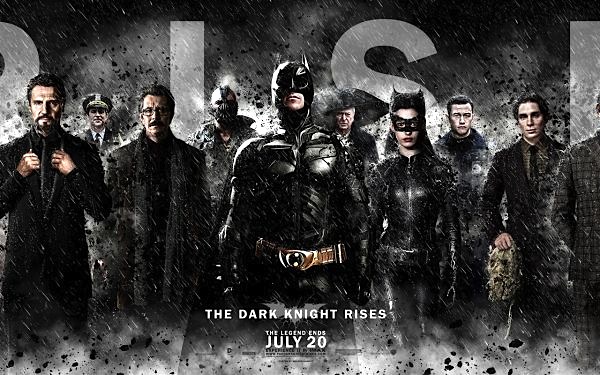At this point, it’s an understatement to say that Christopher Nolan completely changed the level of credibility of not only Batman, but comic book movies in general. Paradoxically — for me anyway — I’ve always found myself more critical of these movies because of this heightened status of legitimacy. And though Batman Begins, and The Dark Knight are both awesome movies, I was always bothered with how little I cared about Batman himself, the person the movies are supposedly about.
The Dark Knight Rises carries a good deal of the brooding pretension of its predecessors. However, it is, refreshingly, a story about Bruce Wayne specifically. And not necessarily how he’s going to enact justice or vengeance, but really, more about a search for personal happiness.
FULL SPOILERS:
So what happened in The Dark Knight Rises? Quite a bit. In fact, this might be one of the most convoluted plots in an action movie, ever. Here’s the spoiler heavy recap:
Bruce Wayne (Christian Bale) is retired from Batman work and a recluse following the events from The Dark Knight. Organized crime is non-existent in Gotham City and Commissioner Gordon (Gary Oldman) is wracked with guilt over the lie he created about Harvey Dent’s faux-heroism. Alfred (Michael Caine) is upset that Bruce has refused to rejoin the world, and has seemingly neither moved on from the death of Rachel nor tried to make a new life for himself. Lucius Fox (Morgan Freeman) is trying to run Wayne Enterprises the best he can, despite Bruce’s lack of involvement or enthusiasm.

Enter into all of this a bunch of new characters: Bane (Tom Hardy), Selina Kyle (Anne Hathaway), Miranda Tate (Marion Coltillard) and a Gotham cop named John Blake (Joseph Gordon-Levitt). Bane is a mercenary (don’t ask too many questions about that) who is plotting something which involves screwing over Gotham. Miranda Tate is a billionaire philanthropist. Selina Kyle is a talented, fast-talking thief who is way in over her head with Bane’s crowd. And John Blake is just a good cop who still believes in the Batman. Despite being a really long movie, these characters are introduced fairly quickly and you accept their involvement in the plot with no problem.
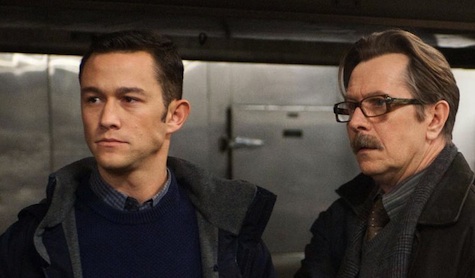
Bane’s goons put Commissioner Gordon into the hospital, which immediately turns the rest of the Gotham Police Department into a bunch of idiots, with the exception of Blake. Blake randomly can just tell that Bruce Wayne is Batman and serves as the official Batman cheerleader for the whole movie. (How this Blake guy figured it out and Gordon didn’t is well…whatever.) He encourages Bruce to come back as Batman, which eventually does happen when Bane attacks the Gotham City Stock Exchange.
Bane and his goons want Bruce to go broke because A.) They know he’s Batman (this is later revealed to be because they’re like The League of Shadows: Reloaded) B.) They want access to all of the weapons from Wayne Enterprises, including a bunch of tank-cars that are exactly like the Batmobile. They also want access to a giant fusion generator, which Bane forces a scientist guy to convert into a bomb. How does making Bruce Wayne broke accomplish this?
Up to this point, nice billionaire Miranda Tate has been trying to “help” Wayne Enterprises out with their green energy projects. Lucius advises Bruce that in order to recover from the money disaster, they have to give her access to the company and all of their stuff, including the big generator.
Batman gives pursuit but the cops follow Batman instead of Bane. Bane and his goons get what they need, which ends up being Bruce Wayne’s fingerprints. Why do they need Bruce Wayne’s fingerprints? They want to make him broke, by using his phony prints to make some bad investments. (Hence the attack at the Stock Exchange.) If you’re paying close attention, this is the lynch pin of the whole movie and everything else that happens comes from it.
The reason the League of Shadows get Bruce’s fingerprints in the first place is because Selina Kyle heists Martha Wayne’s pearls from Bruce’s safe in the beginning of the film. Selina intrigues Bruce and he deigns to appear in public so he can keep track of the swath she cuts through Gotham’s high society. Selina’s intentions are made clear after this. She sees how the rich in Gotham, in the world really, hoard their wealth and she is determined to take that power away from them. But this isn’t all that she’s after.
Bane has little use for Catwoman after she delivers the fingerprints and although she makes a daring escape from their first attempt to kill her, she can’t resist going back in to take more from those who wronged her. This gets her in real trouble, the kind only a rooftop fight with Batman at her back can solve.
Batman and Catwoman form an uneasy trust from this and he offers Selina the one thing she truly wants: a computer program that will wipe Selina’s record clean and allow her to start a new life. All she has to do is find Bane for him.
It doesn’t go well. Batman tries to meet up with Bane but is sold out by Selina Kyle. As Alfred predicted earlier, Bane beats the crap out of Batman. It’s not even a close fight. Bane then sends Bruce Wayne to The Pit, a prison somewhere in India and not-coincidentally the creepy one he came from in the first place.
After this, shit goes crazy as Bane’s army takes over the city with a series of bombs that separate the island of Manhattan Gotham City from everything else. Bane’s guys are in charge now and if any one from “the outside world” tries to screw with them, he’ll detonate the fusion reactor, which has now become a bomb. He claims he is giving the city back to the people, primarily through trapping all the police underground and freeing prisoners that were wrongly incarcerated by Harvey Dent. During this exchange, Bane reveals to Gotham just what Harvey Dent became in his final days and how Commissioner Gordon was complicit in lying to the city about it.
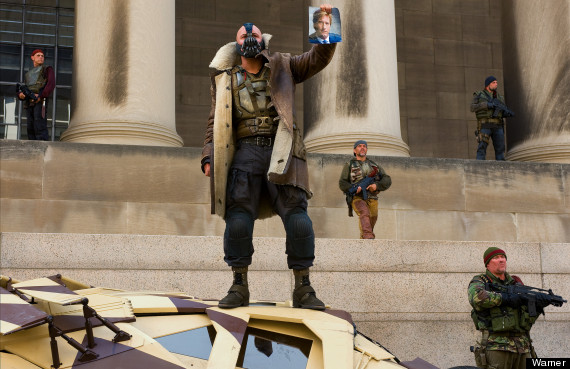
What follows is mostly a movie about Gordon, John Blake, Lucius Fox, and Miranda Tate trying to keep order in the cut-off city. They know that the reactor core in the bomb will degrade after 90 or so days. It doesn’t matter if Bane sets it off, it will go off anyway. Lucius can fix it but first they have to find it. The bomb is carried around in three identical trucks, one real, two decoy, all day and all night.
Bruce does eventually get out of the prison in India by climbing out of the pit and coming to terms with his attitudes about life and death, somewhat in thanks to the spectre of R’as al Ghul. Upon his return he convinces Selina Kyle to help him. (Or at least, help him a little bit before she takes his bike and escapes from the city.) He reveals himself to Gordon and Blake just as they’ve been captured and are about to be executed, and soon these combined forces are able to free the police, locate the bomb, and take the fight to Bane.
Batman can barely stand Bane’s blows during the final fight, but now knows that Bane’s mask is the key. He rips it open but isn’t able to take Bane down until Catwoman makes a surprise appearance, shooting a weakened Bane.
Bane’s alive, but he doesn’t have the trigger for the bomb. Miranda Tate does. Or rather, Talia al Ghul does.
She stabs Batman and makes off with what remains of the League of Shadows. They manage to hijack the truck with the bomb, now only minutes away from detonation, until Batman, Catwoman, and Gordon force them to crash the truck.
There’s now no time to defuse the bomb, so Batman hooks it to the Bat-plane he’s been using and flies away from Gotham. The bomb detonates over the bay.
In the wake of this, the city loves and mourns Batman while Alfred returns to mourn Bruce Wayne. Things seem like they will eventually return to normal. It’s revealed that John Blake’s real name is “Robin” and he goes on to discover the Bat-cave, suggesting he will take up the work Batman began.
In the final scene, Alfred is having a drink somewhere in Florence, Italy and sees a very alive Bruce Wayne and Selina Kyle happily having a drink. They exchange knowing looks.
Phew! Now let’s talk about what it all means.
One complaint I imagine many will be making about this movie is the lack of complexity a villain like Bane has in contrast with The Joker or Harvey Dent. And they would be right, because Bane is a one-note character, whereas in The Dark Knight, the Joker and Two-Face work thematically and logistically with the plot instead of against it. What I mean is this: bad guys with big master plans in movies like this are inherently problematic. Why do they have so many henchmen? What is the endgame? Is the League of Shadows for real? The Nolans brilliantly dispensed of this problem with Heath Ledger’s Joker by having him say, “do I look like the kind of guy with a plan?” This, very uniquely unburdened the movie from the usual pitfalls of big bad guy plots.
Bane isn’t like that. Bane is more like a bad guy from a James Bond movie combined with, well, the character Bane from the Batman comic books. He’s just a really, really big asshole. In a somewhat surprising move, I was a little shocked that the initial backstory for Bane’s origin was thematically quite similar to Tom Hardy’s OTHER big villain character, Shinzon from Star Trek: Nemesis. He grows up in a prison, a terrible pit, which molds him into a terrible evil person who is really good at being evil.
In a big ending twist, however, Shinzon Bane’s origin turns out to actually be Talia al Ghul’s origin. She was the first person to escape from the Pit and Bane was her protector. This was almost exactly like the end of the Bond film The World is Not Enough in which Elektra King is revealed to be the eleventh hour bad guy, instead of the bald thug Renard. Am I saying these aspects of the movie were formulaic and derivative? Yes, but not to the point of making the film crumble. Mostly, the formulas made things predictable.
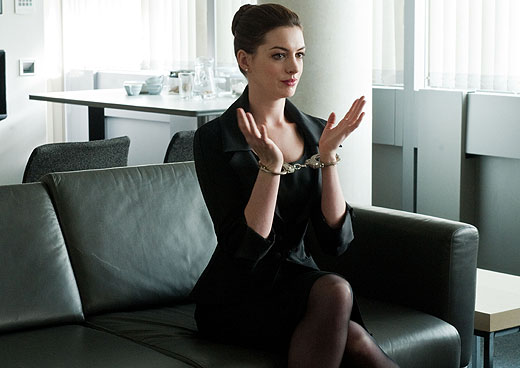
The introduction of Miranda Tate immediately put me on guard because I know the formula of this kind of movie: you can’t have two love interests for your main character. So, while I was happy to be proven right when Miranda Tate/Talia turns on Gordon and Batman, I wasn’t surprised. If Catwoman (Is she really Catwoman? Nobody calls her that!) hadn’t been in the movie, we might have liked and trusted Miranda right along with Bruce for longer, but the simple presence of the other character sort of ruins that reveal.
Also, Bane’s motivations get dubious when his true origins come out, as he doesn’t seem to be a League of Shadows devotee, but instead sort of a guy in love with someone else who is just using him. This doesn’t make the character uncool or anything, but it does make the themes a bit more muddled.
Luckily, the muddled nature of all these other characters isn’t a big deal, because for once, Bruce Wayne/Batman’s arc is very clear. The film opens with him crippled, depressed and broken. When he jumps back into the game because Catwoman gets him excited and because Bane is genuinely a new threat, he is hugely foolhardy and he pays for it.
Wrapped up in all of this is Alfred continually urging Bruce to move on and get a life. In a speech to Bruce at the beginning of the film, Alfred tells Bruce of a day he has always longed for: He’ll sit down in his favorite cafe in Florence, order a drink, and spot Bruce there living a happy, anonymous life free of Batman. They’ll exchange glances and never speak of the fact that everyone has moved on from the horror of Gotham. It’s an odd speech to process at first, but it’s incredibly touching because Michael Caine is the best person alive and delivers it beautifully. Christian Bale, for his part, is also playing a Bruce Wayne who actually feels really, really damaged.
In the previous Nolan movies we’re told over and over again how insane Bruce Wayne is and what a tough life he’s had. But his romance with Rachel (both the Katie Holmes and Maggie Gyllenhaal versions) seems sort of creepy and unrelatable. It’s a childhood crush. A rich-person betrothal. They never really seem to have chemistry. But this time, Bruce Wayne’s human tendencies are totally on display. He is attracted to Selina Kyle right away and he’s instantly drawn toward Miranda Tate’s confidence, in comparison to how shiftless he feels. When they sleep together, it’s an act that’s full of need.
Finally! Christian Bale’s Batman is a person! He has sex! He has desires! He wants to be happy! All of this is punctuated with Alfred’s insistence and anger with him over being reckless with his own life. Carrying over with continuity from the previous film, when Alfred reveals he burned the letter from Rachel, the one that said she had chosen Harvey Dent, the emotional catharsis for Bruce Wayne gets real. He is broken by his feud with Alfred and the revelation that Rachel was not waiting for him before she was killed.
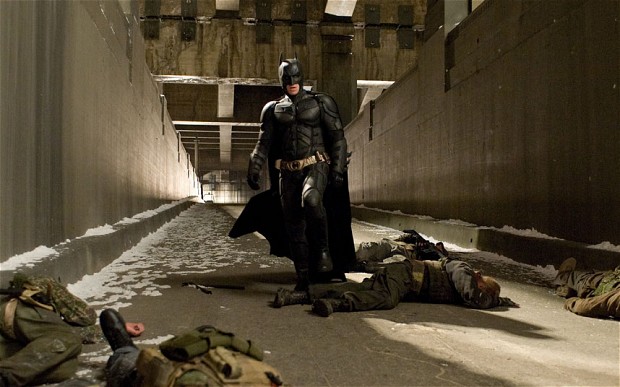
This is developed further after Bruce is exiled to the Pit. He’s angry and motivated, but he’s still being held back by the fact that he doesn’t fear death like he should. One of Batman’s defining qualities is suddenly turned from a morbid brooding intensity into something that needs to change and be dealt with. How can Batman fight for his life, for the things he believes in, if he doesn’t value his own life? What’s the point of making Gotham safe for others if you can’t be happy? The Dark Knight Rises answers this question. In this film, Bruce Wayne transforms from being a self-righteous martyr and into a true and real hero.
I predicted a lot of the plot points and twists in this movie. But I did not assume that gloomy Christopher Nolan would show me a smiling, and alive Bruce Wayne sitting in the sun with Selina Kyle at the end of the movie.
And that was the biggest twist of all in The Dark Knight Rises: It ended in the light.
Ryan Britt is the staff writer for Tor.com and didn’t even get a chance to talk about the Scarecrow’s amazing kangaroo court, that’s how complex this movie was.










